Sony Xperia X Performance vs Samsung Galaxy S7
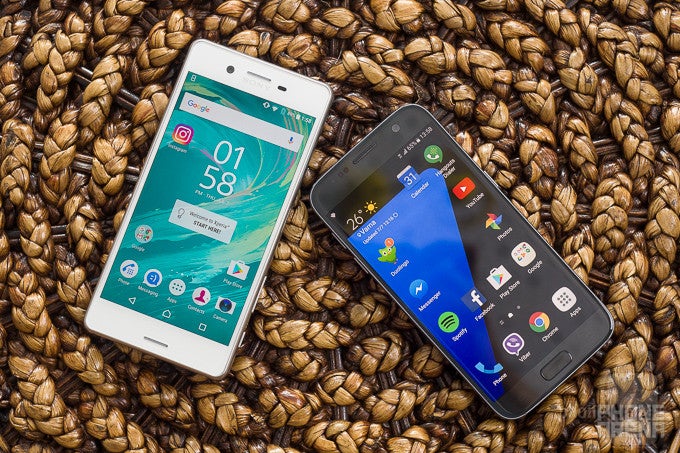
Introduction
Sony made headlines at this year's MWC edition by announcing a trio of phones aimed to form a completely new X-line portfolio, bidding adieu to the Z-line that has been shaping its Android strategy for a few years now. Top of the line here is the Xperia X Performance, and that's exactly the handset we are going to clash with Samsung's finest in the category – the Galaxy S7. Both fit in the 5” display realm, sport the latest Snapdragon chipset, have powerful cameras, and cost a similar amount, so which one takes the cake? Let's see...
Design
Fatboy X in metal against glass Slim Jim, not much of a water gun fight here
We aren't going to mince words here – while the new X-series is a departure from the familiar Sony Z design, it's not much of a change in form, just the glass back got replaced by other materials. The fairly chubby and rectangular X Performance has a back panel made of metal, but it rings somewhat hollow when you tap on it, and the keys all around the phone are shallow, with poor tactile feedback. The SIM card tray is all-plastic and rather flimsy, too.

The S7, on the other hand, is slim and fashionable in its glass-and-metal chassis, with sturdy, easy to feel and press buttons. It also fits much more comfortably in the hand, not only because it's slimmer, but also on account of the tapered backsides.
Despite that the fingerprint sensor is moved to the side of the Sony phone, embedded in the lock key, its screen-to-body ratio remains poor, and the 5” display barely occupies 67% of the front surface. That's largely thanks to the two front-facing speakers, which, let's face it, aren't going to produce much of a stereo sound at that spacing anyway. The Galaxy S7 has a finger scanner that is housed in the home key beneath the display, and still returns way better screen-to-body ratio.
The Sony handset has an IP68 water resistance rating, meaning that you can dip it in up to three feet of water for at least half an hour. The same is valid for the Galaxy S7, yet it feels downright elegant in its thin glass-and-metal chassis, when compared to the X Performance.
Display
On par at the beach, more credible indoors – the Quad HD AMOLED takes the cake
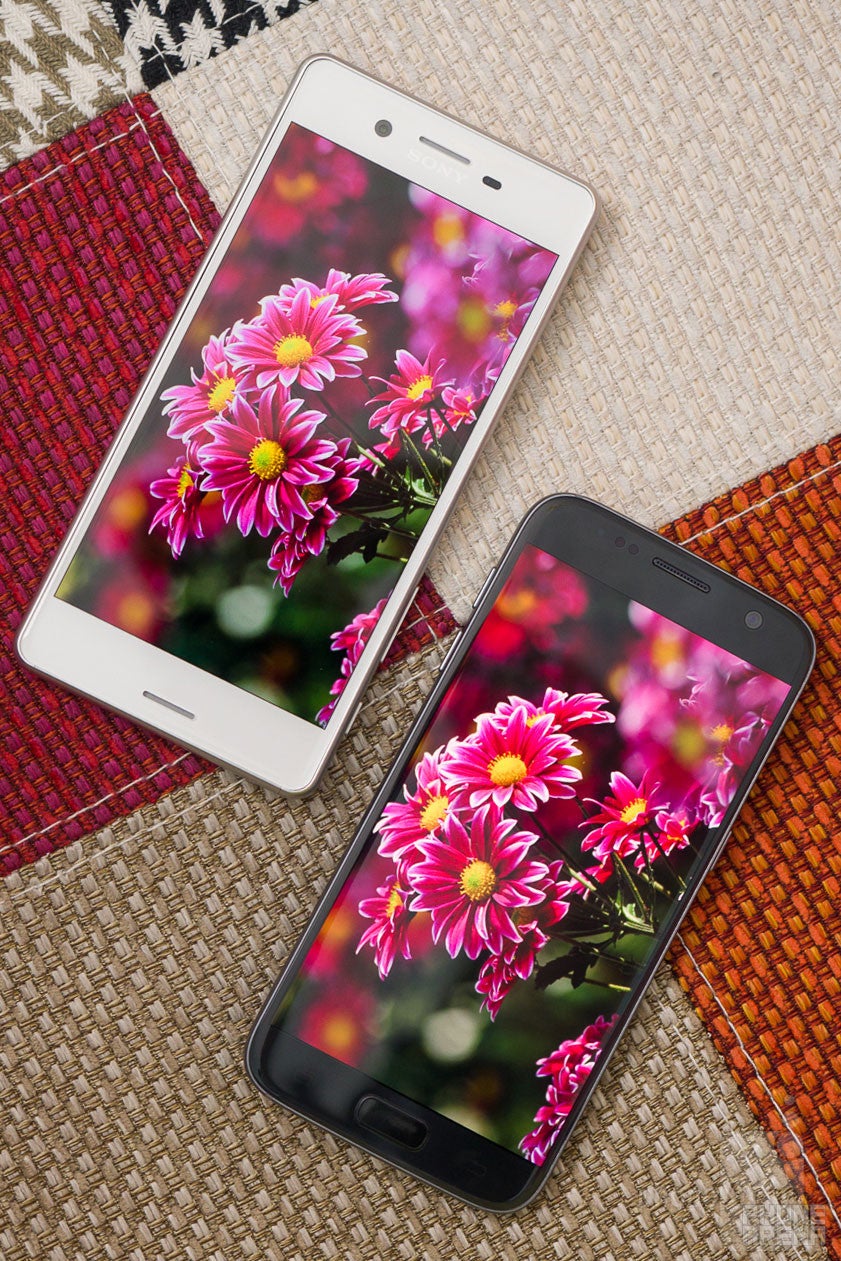
Sony again went with very, very cold colors and way oversaturated greens for the screen's color balance. While it argues that this setup aids outdoor visibility, we'd rather have a more natural color mode to choose instead. The X Performance has a very good peak brightness of 547 nits, and the display is easily visible outside, with low reflections – a tad better than the Galaxy S7's panel.
Samsung's display, on the other hand, has a Basic mode that returns colors which are pretty close to the standardized gamut in terms of temperature and saturation. The default Adaptive mode goes on the cold and saturated side of the spectrum still, but not as much as the X Performance.
Interface and functionality
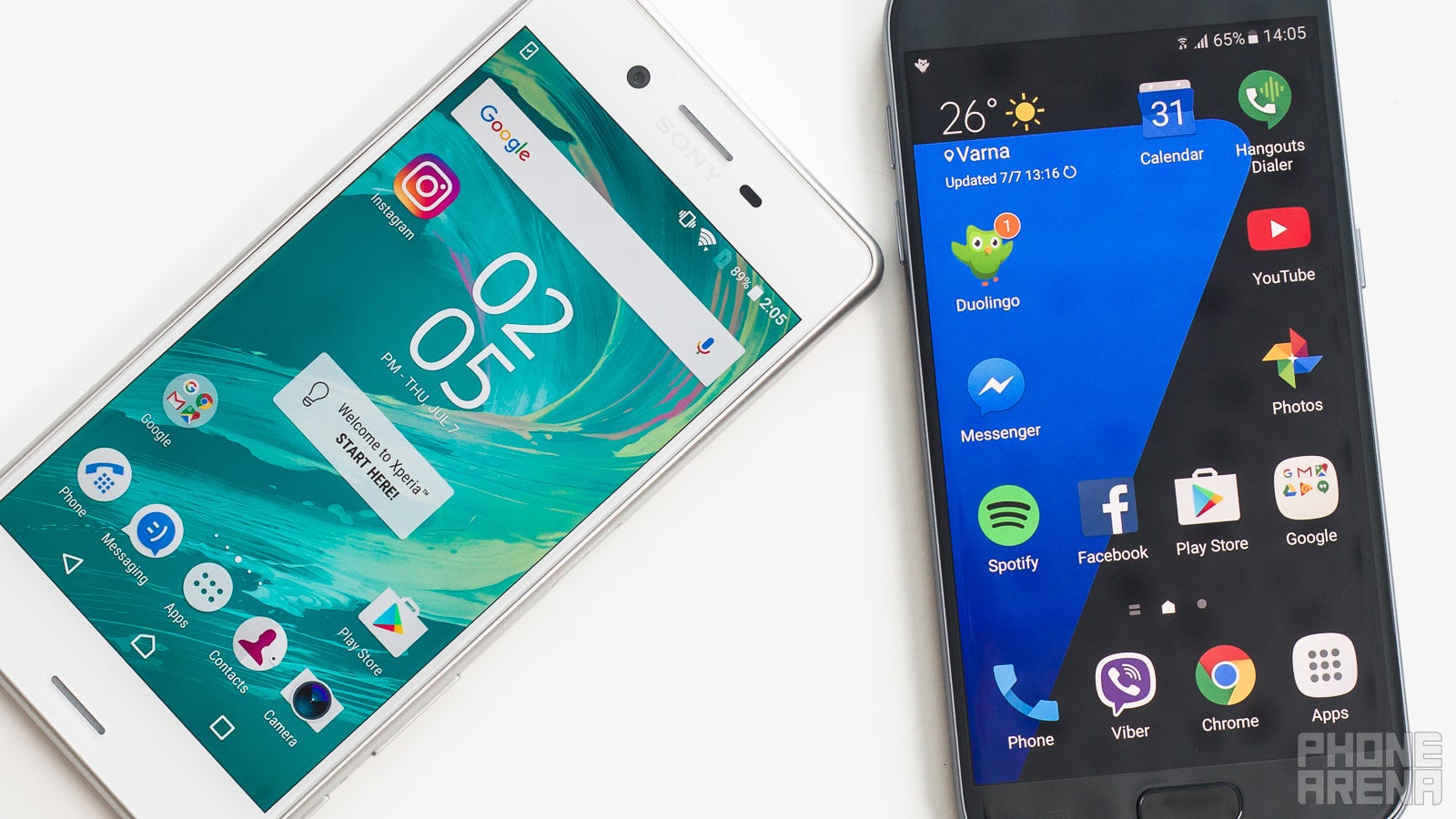
The Sony UX on the X Performance is pretty close to the stock Android 6 Marshmallow beneath, save for icon skinning and Sony's own media, health, news, and (naturally) PlayStation apps. This is actually a good thing – in the settings, for instance, Sony dresses things up with some colorful new icons, but everything still lives where you'd expect it to – there's no time wasted having to relearn Android's UI just because you're picking up a new phone from a new manufacturer. Sony did add some very useful options, though, like the ability to lock and unlock the display by simply tapping twice on the glass.
Samsung's TouchWiz, on the other hand, is heavily customized, with plenty of extra functionality you might or might not need often, if at all. It also loads the Galaxy S7 with a smorgasbord of Samsung's own apps and services, some useful, some not that much. Good outliers here are the S Health app, as well as the excellent Samsung Pay system that uses the finger scanner beneath the display to authenticate payments and works everywhere magnetic stripe cards are accepted.
Processor and memory
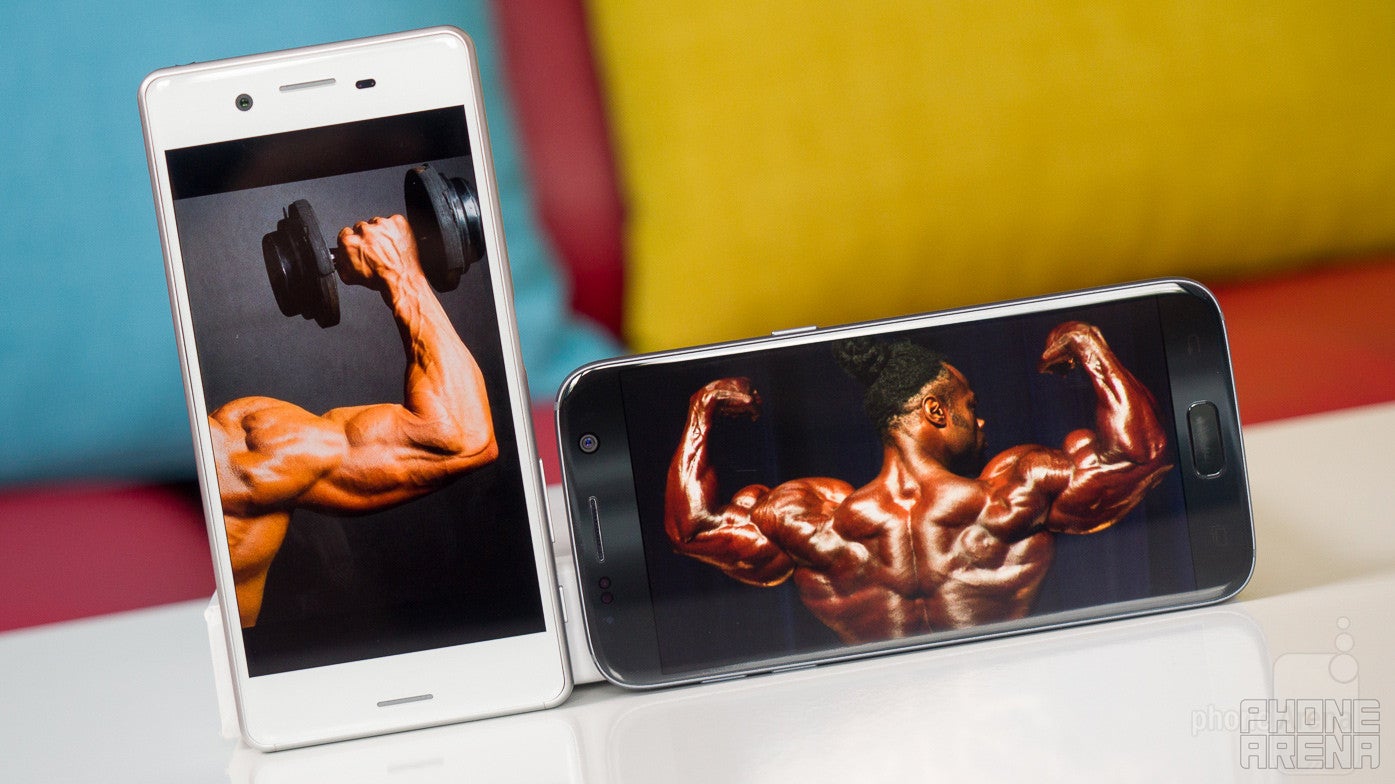
The “Performance” part in the Sony phone's name stems from the use of the latest Snapdragon 820 chipset, instead of some middle-of-the-road package. Samsung, however, also uses it in the US version of the Galaxy S7, and abroad it even equipped the S7 with a scorching Exynos 8890, so no complaints about horse power in both phones. The Xperia has a slight advantage in graphics benchmarking, as it simply has to push a lot less pixels than the S7, but that's not something you'll notice in everyday usage.
The Galaxy has the upper hand in terms of RAM, as it has 4 GB against the 3 gigs in the X Performance, but TouchWiz is also much heavier to move around than Sony's simple overlay. The phones will start you off from 32 GB of internal memory, and both offer microSD slots for expansion.
Connectivity
Being an unlocked GSM phone sold without big carrier involvement, the Xperia X Performance can only be used on AT&T and T-Mobile, while the S7 has versions for Verizon and Sprint, with support for a tad more LTE bands. The phones come with all the typical connectivity options you can expect from flagship handsets these days, with the main difference being Sony's support for both Miracast and DLNA wireless media streaming standards.
Miracast is quite the mess at the moment, though, while Samsung has one big advantage when it comes to connectivity – the Samsung Pay system that emulates the magnetic strips of your credit or debit card, so you can use the S7 to pay on the vast majority of POS terminals worldwide.
Camera
Definition of insanity – Sony putting high-res, small-pixel sensor each time, and expecting different results

The Xperia X Performance has 23 MP 1/2.3" sensor with 1.12 micron pixels and optical image stabilization. It has an aspect ratio of 4:3, and the lens carry an f/2.0 aperture, so at least on paper we wouldn't expect wonders from such a setup. To help with focus performance, the Sony Alpha team ensured the X Performance offers its Predictive Hybrid Autofocus tech for quicker locks. Up front, we've got a very generous, 13-megapixel sensor with wide, f/2.0 lens. The rear camera can be launched with the dedicated two-stage shutter key on the side, which comes in handy for quick snaps, or with quick pressing of the lock button two times, just like on the S7.
On the software side, we're treated to an experience identical to that with the Xperia Z5. The camera app is more minimalist than before, and offers easy and quick operation. The specialized modes that are included out of the box are Face in picture, Style Portrait (various filters and effects), and Timeshift video (slow motion), while extra shooting regimes can be downloaded through the camera app.
Тhe Galaxy S7 flaunts a larger sensor with lower 12MP resolution, but way bigger, 1.4 micron pixels, and much wider, f/1.7 aperture. On paper, these specs would allow it to soak in more photons than the camera on the Xperia, which is crucial for low-light performance. On the front side of things, the Galaxy S7 has 5MP selfie camera, capable of capturing face and group shots with wide-angle lens.
As for focusing technology, the Galaxy S7's camera features Dual Pixel Phase Detection auto-focus. Instead of each pixel comprising a single photodiode for image capture, the Dual Pixel CMOS sensor allocates two photodiodes for every single pixel. In short, this makes focus quicker and more accurate, both for photos and video recording. The interface allows you to choose from a wide variety of shooting modes and color effects, too.
When it comes to imaging quality, the color presentation round goes to Sony's phone, as the Galaxy S7 shoots in warmish, rather yellow hues, with unnatural saturation boost. The Xperia goes a tad on the cold side, compared to reality, but the deviation is not nearly as visible as with the S7. Samsung's phone captures more detail, though, and its pics are sharper, yet with much less noise creeping into the frame, plus it handles scenes with wider dynamic range better. Indoors and at night the Galaxy S7 proves superior, producing sharp photos that highlight the shadows and don't overexpose brighter objects like the Xperia does.
Despite its powerful chipset and image processor, the X Performance doesn't really perform when it comes to 4K video, as it only maxes out at 1080p Full HD recording with 60fps. The Galaxy S7 records and plays 4K without a hitch, on the other hand. Video definition levels aside, the handsets record fluid footage, with quick exposure compensation while panning. The video footage quality takes a cue from the still imagery – Galaxy S7 records sharper details, but unnaturally warm colors, while the Xperia footage is softish, but with more realistic coloring that is yet still on the colder side.
Here we have to stop and praise the focusing systems on these handsets. Sony's Predictive Hybrid AF and Samsung's Dual Pixel phase-detection tech are the best that you can currently find on a phone. Thsi shows not only in our benchmarks below, which put the S7 at first, and the X Performance at second place in terms of camera speed, but also in the excellent continuous autofocus systems that move seamlessly back and forth between near and far objects. Samsung's Dual Pixel tech is still a bit faster to adapt, but the difference is pretty negligible, so kudos to both Sony and Samsung here.
Multimedia
The X Performance flaunts a set of front-facing speakers, which, however, aren't very loud or deep – waterproofing comes at a price. The single speaker on the Galaxy S7 actually fares a bit better in terms of strength, even though it's IP68 rated, too. The audio players on both phones offer rich equalizer and audio quality settings to play with, but Sony's music interface is much more polished and elegant looking.
The X Performance uses houses both its own “Album” gallery with picture editing options, as well as the stock Google Photos app, which offers cloud storage with auto-sync. Samsung also has its own capable gallery take in addition that doesn't take forever to load like the default Google app.
As for video playback – both phones sport very capable players that support a number of popular formats, as well as subtitles and basic editing. Video just looks better on the AMOLED display, though, as it offers deep true blacks and higher contrast.
Call quality
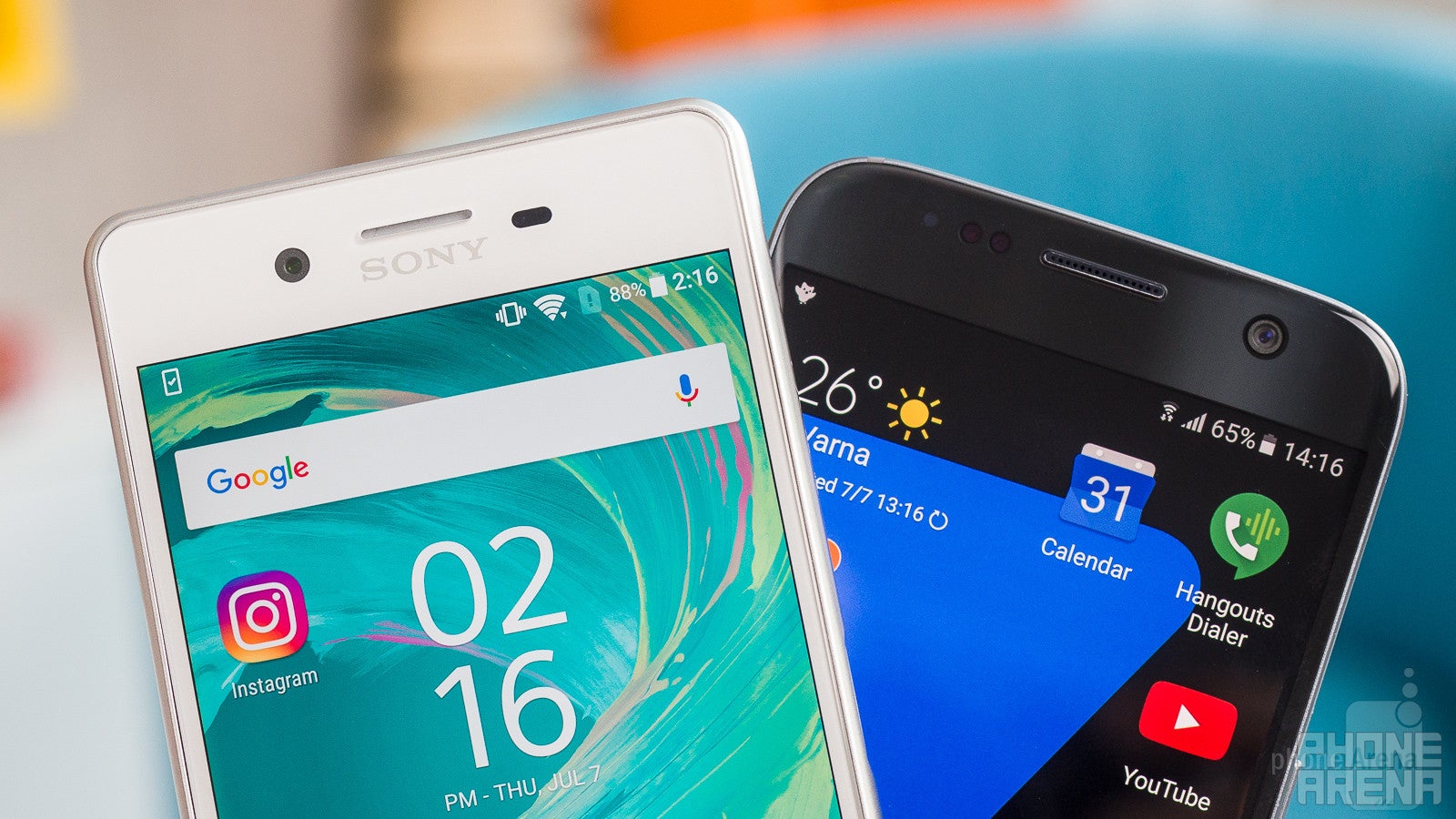
Even with fringe levels of signal, our calls from the X Performance came through with satisfying clarity and volume on both ends. Then again, this is the sort of thing we take for granted to such extent that it's hard to pat Sony on the back for doing a passable job.
On the Galaxy S7, voices pack a lot of substance through the earpiece, clean and without any distortion. The good fortune extends to the other end of the line as well, where the microphones in the phone help to produce voices to our callers that are audible and distinctive.
The S7 offers an ‘extra volume’ mode for those times when it’s noisy around. Without it enabled, the volume is still plenty loud for our liking, more than capable of accentuating every word and syllable uttered by our caller.
Battery life
Nothing to see here, people, move on, just the rapid Galaxy S7 charging times

In our test, however, the phone's 2700mAh battery managed to eke out just a little over 6 hours of screen-on time, which is good for general usage of about a day, day and a half at the max on average. The S7 and its 3000 mAh battery didn't fare much better, though, as it survived 6 hours and 37 minutes on our test, both unremarkable performances.
Perhaps the most disappointing thing about the Sony phone's battery isn't the actual endurance, but its recharge times; despite the inclusion of a quick charger, the Xperia X Performance still takes nearly 50 percent longer than the 88 minutes of the S7 to go from discharged to full. Moreover, the Galaxy also has lightning fast wireless charging which can top it off in about two hours time – that's the fastest we've seen on a phone so far.
Conclusion
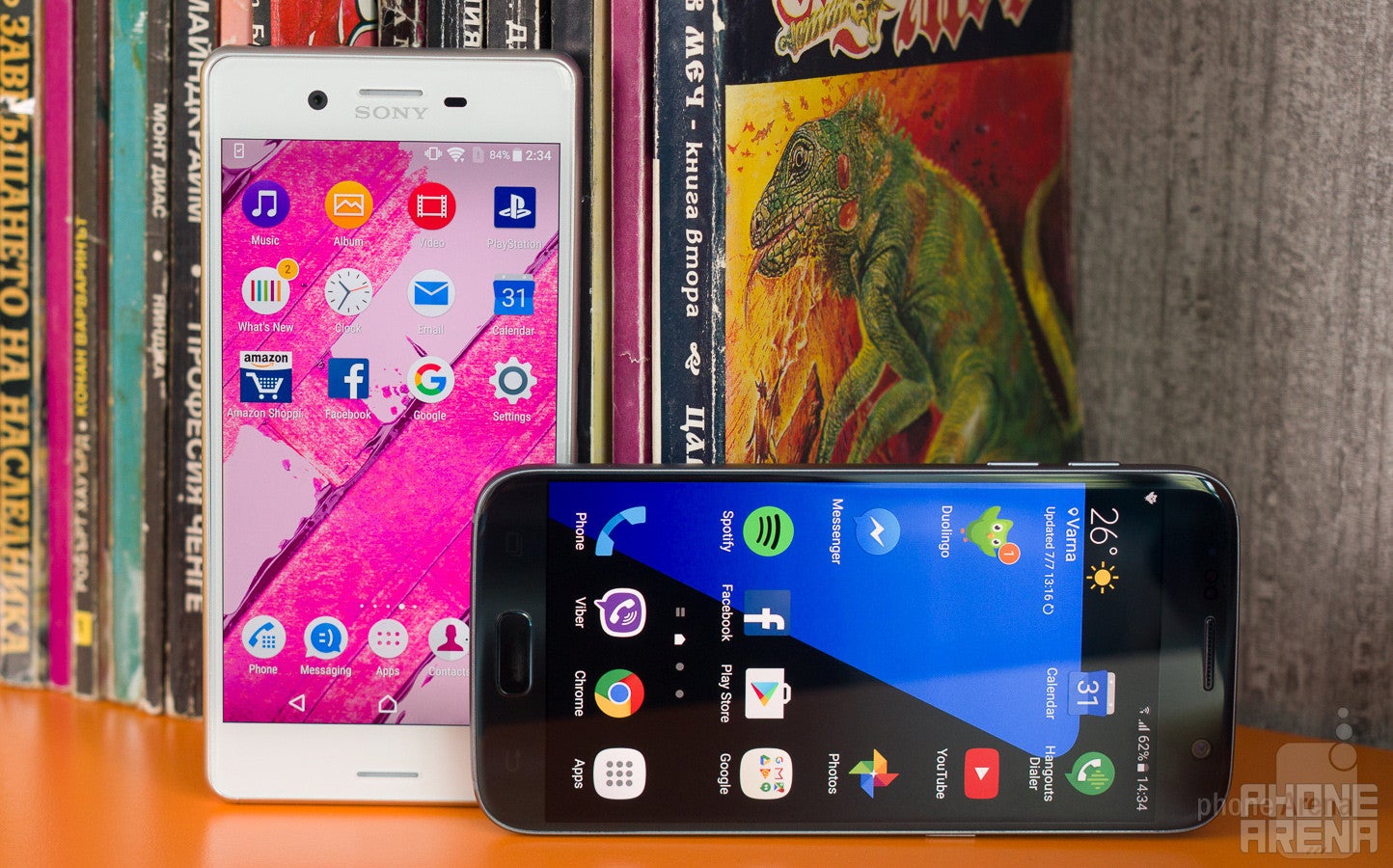
With a more elegant and palm-friendly chassis, superior camera, and much faster charging, the Galaxy S7 is the clear winner here. On paper the phones are near equals, but when we got down to the details, Samsung's flagship turned out to be better in almost every important aspect of daily operations. Moreover, Sony priced its finest for the season on par with the Galaxy S7, yet it will be sold unlocked in the US for usage on AT&T and T-Mobile only, and with a finger scanner missing. Thus, the Xperia X Performance is not in a fair fight against the S7 in the US, but even in other markets, the Galaxy S7 is definitely the better choice.
Sony Xperia X Performance
Pros
- A tad better outdoor visibility
Samsung Galaxy S7
Pros
- Better camera overall
- Tighter performance
- Very fast charing

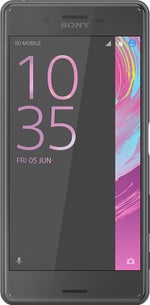

























Things that are NOT allowed: